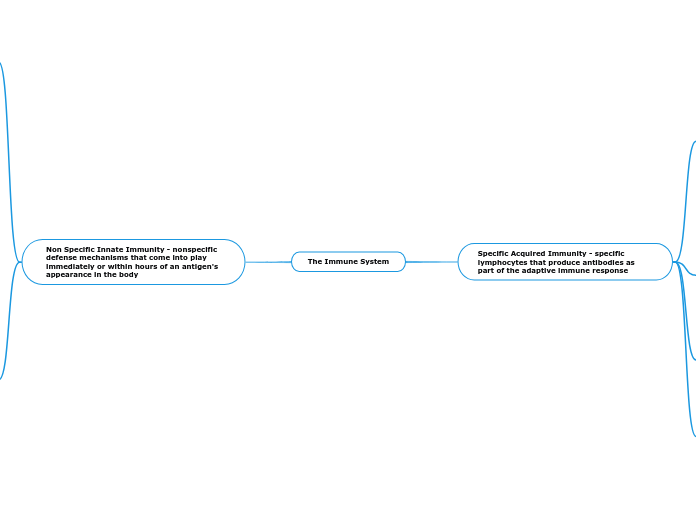The Immune System
Specific Acquired Immunity - specific lymphocytes that produce antibodies as part of the adaptive immune response
Naive T Cells - lymphocytes that matured in the thymus
Helper T Cells - coordinate immune responses by communicating with other cells
Killer (Cytotoxic) T Cells - destroy cells that are infected with the specific pathogen
Memory T Cells - remember the pathogen for a faster response if there is a subsequent exposure
Suppressor (Regulator) T Cells - subdue other T and B lymphocytes after an infection is cured
Naive B Cells - lymphocytes that matured in the none marrow
Plasma Cells - create antibodies that are specific to antigens of the pathogen
Antibodies - proteins created by plasma cells in response to specific antigens
Memory B Cells - recognize pathogens for a more rapid plasma cell response if there is a subsequent exposure
Naturally Acquired - occurs when a person is exposed to a live pathogen, develops the disease, and becomes immune as a result
Passive - antibodies passed from mother to fetus or mother to child through breastfeeding
Active - actual infection by a pathogen
Artificially Acquired - occurs when a person is given an infection of transfusion of antibodies made by someone else
Passive - antibodies transfused into a person
Active - immunization
Non Specific Innate Immunity - nonspecific defense mechanisms that come into play immediately or within hours of an antigen's appearance in the body
First Line of Defense - provides protection against all types of potential pathogens or other potential threats by prevention of entry into the body
Chemical
Saliva
Acids in the Stomach
Mucus
Physical Barriers
Skin
Cilia
Earwax
Genetic
incompatibility of genetics of human and cat does allow a human cold to affect the cat, and vice versa
Second Line of Defense - non-specific phagocytes and other internal mechanisms that comprise innate immunity
Inflammation - the reaction of living tissue to local injury, which purpose is to destroy, dilute and isolate the invader
Granulocytes - a type of immune cell that has granules
Neutrophils - respond to bacterial and fungal infections by destroying bacteria by phagocytosis
Eosinophils - respond to parasitic infection and allergic response by releasing many substances that neutralize toxic compounds
Basophils - respond to tissue injury by releasing chemicals, histamines and heparin, that cause inflammation
APC Phagocytic WBC
Dendritic Cells - process antigen material and present it on the cell surface to the T cells of the immune system (act as messengers between innate and the adaptive immune system)
Monocytes - WBC that move throughout the bloodstream
Macrophages - large, specialized immune cells that recognize, engulf, and destroy target cells in tissues
Natural Killer Cells - immune cells that recognize infected human cells and cancers, which they will attack and kill the abnormal cell
